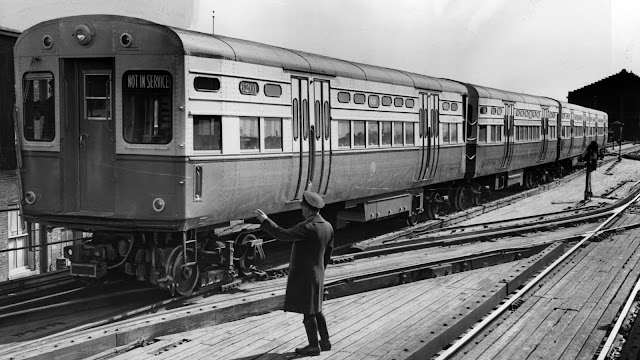 |
| chicago-l.org |
 |
| www.capitalgazette.com |
July 6, 1954 – The last of the wood and steel elevated cars that have been in use for 54 years are removed from the Lake Street branch of the elevated system. The general manager of the Chicago Transit Authority, Walter J. McCarter, announces that there are now enough modern cars out of an order of 250 cars to allow the Lake Street elevated line the use of all-metal cars. Because the Lake Street elevated does not enter into the city’s subway system, it has had to continue to use aging equipment as the result of a city ordinance that specifies any elevated branch leading into the subway must use all metal cars. The new elevated cars, about 150 of which have arrived in the city, have been converted by the St. Louis Car Company from the “Green Hornet” street cars, the conversion costing approximately $32,000 for each car. The top photo shows a Loop-bound set of wooden cars headed for the Ashland station. Below that is the type of elevated car that replaced the wooden cars. That train is made up of cars converted from street cars.
July 6, 1915 – On its way to the Panama-Pacific Exposition in San Francisco, the Liberty Bell Special makes a stop at the La Salle Street station on a rainy evening. Three hundred police officers are stationed around the station as “modern patriots by the thousands – grown patriots and patriots of the public schools, war patriots and peace patriots, Republican, and Democrat, and Socialist patriots – stormed the station.” [Chicago Daily Tribune, July 7, 1915] Some were fortunate to gain entrance to the station, but “tens of thousands” had to remain outside in a downpour. When the train arrives, over an hour behind schedule, three Army buglers, “trim and ramrod straight” signal its entrance. Then the line of people that stretches from Van Buren to Monroe Streets begins an orderly entrance to view the Liberty Bell, which stands on a specially constructed flat car, suspended in a wooden frame. A special guest is 10-year-old Margaret Cummins of 1102 Wellington Avenue, whose great-great-great grandfather, Jacob Mauger, took the bell to his farm and buried it when he learned that British soldiers were coming to seize it. The bell remains in the city until midnight when it begins the next leg of its coast-to-coast trip. This is the second trip that the Liberty Bell has made its appearance in the city ... the first visit was a much longer stay at the 1893 World's Columbian Exposition as the above photo shows.
July 6, 1935 – The razing of the old Coast Guard station at the mouth of the Chicago River begins, work that is expected to take three weeks to complete. Dedicated in 1903, the station’s days became numbered when part of it was destroyed by fire in 1933. As soon as the demolition is complete, work will begin on a new station with work expected to wind up by late fall. The old station had responded to 8,454 calls for assistance. The old station with flag still flying proudly is shown above, along with the photo showing the station today.
July 6, 1964 – The 35-story Equitable building, now 401 North Michigan Avenue, is topped out in a light rain as a 35-foot white beam with the names of 6,000 Chicagoans written on it is hoisted into place at the top of the tower. Also on the beam is the number 192,113,484, corresponding to the population of the United States at this time. The building, designed by Skidmore, Owings and Merrill in the mid-century modern style, is already 75 percent rented. At a luncheon for about 200 civic and business leaders at the Sheraton Chicago Hotel, James F. Coates, the chairman of the Equitable Life Assurance Company of the United States, says that the landscaped area to be built south of Tribune Tower and in front of the Equitable building will be “the most beautiful in the world.” [Chicago Tribune, July 7, 1964] Today the trees that have stood in that area for 44 years have all been cut down and the area to the southwest of the tower is the site of the Michigan Avenue Apple store, which opened in the Fall of 2017. In the above photo 401 North Michigan rises to the behind J. Seward Johnson's sculpture, Return Visit.









2 comments:
v
Looking for a trusted truck repair shop in Texas that keeps your rig running strong? At Texas Truck Repair, we specialize in fast, reliable, and affordable services designed to minimize downtime and maximize performance. Whether it’s routine maintenance, emergency roadside assistance, or heavy-duty repairs, our expert mechanics are here to get you back on the road safely. Choose the Texas truck repair experts that truckers trust for quality, efficiency, and unmatched customer service.
Post a Comment